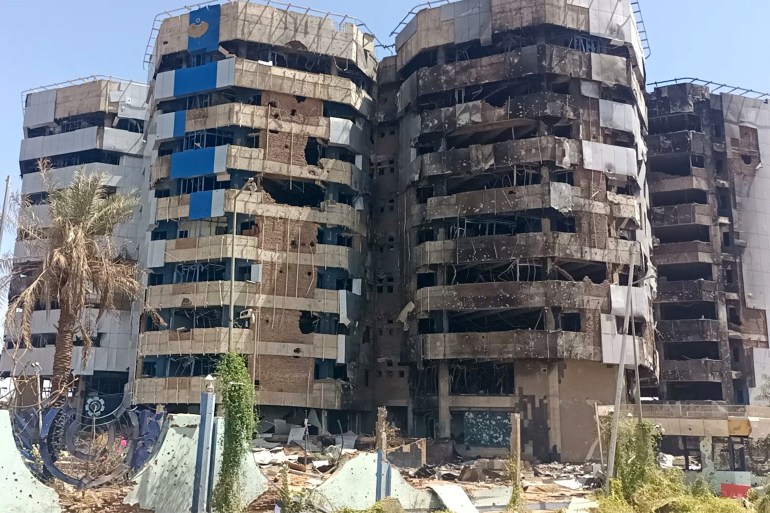As the conflict between the Rapid Support Forces (RSF) and Sudan’s army nears its two-year mark, the capital’s Khartoum has won some significant victories.
However, the conflict between the Sudanese Armed Forces (SAF) and its paramilitary rival, which has ravaged the nation, appears to be continuing.
The country’s territorial integrity may be compromised as a result of the parties’ attempts to establish themselves in the territory now feared to have been supported by each other.
What regions have been taken over by the army?
This month, the Sudanese army and its supporters are celebrating two significant victories.
After his forces took control of the airport from the RSF, imposing full control over the city and causing paramilitary troops to flee southward, army chief Abdel Fattah al-Burhan declared that Khartoum is “free” on Wednesday.
At the start of the war in April 2023, the RSF had seized control of the airport, giving it a tactical and psychological advantage.
The SAF won the airport victory less than a week after its soldiers successfully recaptured Khartoum, marking a significant symbolic victory in the counteroffensive it launched against the RSF in September of last year.
For the first time in two years, Al-Burhan, the country’s de facto leader, entered Khartoum as he announced the full takeover of the city.
What impact will Khartoum have on the outcome of the war?
Khartoum became a key component of the conflict after RSF fighters initially seized some of its territory.
The army now anticipates that its capture will signal a shift in the battlefield’s momentum that could reach other regions.
As both RSF chief Mohamed Hamdan “Hemedti” Dagalo and al-Burhan try to court regional leaders, their influence on the capital’s status may also have an impact on international perceptions.
Retaking Khartoum could give the SAF more leverage in any potential peace negotiations despite the SAF’s refusal to engage in peace talks with its rival.
The RSF used Khartoum airport as a supply and logistics hub while using it in its propaganda and media coverage to highlight its ability to challenge state control.
The army could now exercise better control over supply lines and maneuver with the political symbolism of recapturing Khartoum and the rest of Khartoum.
Does this indicate that war is on its last legs?
The army and RSF leaders argued over the paramilitary’s integration into Sudan’s armed forces, which caused the conflict to break out.
Because that conflict is more pervasive, and the army and the RSF continue to hold onto large swaths of land while engaging in fierce fighting, making it unlikely that the war-torn nation will ever reach peace.
Fighting is still occurring in the vast Darfur region to the west of Sudan, the Kordofan region in the country’s central and southern regions, and Gezira state, a strategic agricultural hub south of the capital.
No sign of a political settlement or peace process is imminent, and neither side has been able to win the support of its regional supporters.
In fact, the army and the RSF have increasingly launched massive airstrikes in urban areas, causing numerous civilian casualties to fall.
The UN High Commissioner for Human Rights, Volker Turk, said in a statement on Wednesday that he was “deeply shocked” by reports that hundreds of civilians were killed in a strike this week on a busy market in the town of Tora, which is located northwest of el-Fasher city in North Darfur.
What are the war’s humanitarian effects?
One of the worst humanitarian crises in history is still raging because of the power struggle between the two generals and their allies.
More than 12 million people have been forced to leave their homes, many of them to neighboring countries like Ethiopia and South Sudan. With such a lack of resources, countless people are residing in impromptu shelters, camps, or host communities.
Local businesses and non-profits continue to volunteer their services, but parts of Darfur and other areas are experiencing famine conditions and a population squeeze that is putting people at risk.
600, 000 of the nearly 25 million people infected with dire food shortages are “on the brink of starvation,” according to a recent UN report.
The RSF has been accused of systematically looting supplies while the other side of the conflict has been accused of preventing aid from reaching areas that the other has controlled.
Additionally, food production has been hampered by the fighting’s agricultural disruptions.
Millions of children in urgent need of assistance are among the country’s healthcare system, which has largely collapsed, hospitals being destroyed or occupied.

What follows?
Experts and stakeholders, including the African Union, have warned that Sudan’s civil war may ultimately result in de facto fragmentation.
The RSF and its allies signed a “founding charter” for a breakaway government last month, which the UN Security Council also expressed “grave concerns.”
Similar conflict and dual power structures that have ravaged South Sudan for decades led to South Sudan’s secession in 2011.
The most likely scenario, given that neither side has indicated it is willing to compromise, appears to be one of attrition in the absence of further international pressure.
Source: Aljazeera





Leave a Reply